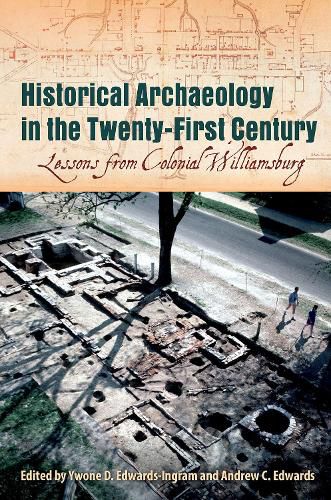Readings Newsletter
Become a Readings Member to make your shopping experience even easier.
Sign in or sign up for free!
You’re not far away from qualifying for FREE standard shipping within Australia
You’ve qualified for FREE standard shipping within Australia
The cart is loading…






This title is printed to order. This book may have been self-published. If so, we cannot guarantee the quality of the content. In the main most books will have gone through the editing process however some may not. We therefore suggest that you be aware of this before ordering this book. If in doubt check either the author or publisher’s details as we are unable to accept any returns unless they are faulty. Please contact us if you have any questions.
This volume is the first to offer an in-depth look at historical archaeology, public history, and reconstruction in Williamsburg through a comprehensive range of sites, topics, and analyses. Uniquely combining a historical landscape and a large town museum complex, Colonial Williamsburg has deeply influenced the discipline for 100 years through one of the nation’s longest continuously running archaeological conservation programs.
Historical Archaeology in the Twenty-First Century illuminates the town’s history as an early capital of the Virginia Colony and home to the College of William & Mary. In the 1700s, Williamsburg was a center of political, cultural, and commercial life where people of African, European, and Native American descent interacted regularly. The case studies in this volume cover topics including animal husbandry, the oyster industry, architectural reconstruction, window leads, and an apothecary’s display skeleton. Contributors draw attention to the interactions between enslaved and free communities as well as African American burial practices.
Using exemplary approaches and methodologies, this volume addresses key concerns in the field such as amplifying voices of the African diaspora, the development of ethically sound inclusive archaeologies, the value of environmental analyses, and the advantages of virtual models. The research highlighted here provides state-of-the-art examples of how historical archaeology can be used to inform, engage, and educate.
$9.00 standard shipping within Australia
FREE standard shipping within Australia for orders over $100.00
Express & International shipping calculated at checkout
This title is printed to order. This book may have been self-published. If so, we cannot guarantee the quality of the content. In the main most books will have gone through the editing process however some may not. We therefore suggest that you be aware of this before ordering this book. If in doubt check either the author or publisher’s details as we are unable to accept any returns unless they are faulty. Please contact us if you have any questions.
This volume is the first to offer an in-depth look at historical archaeology, public history, and reconstruction in Williamsburg through a comprehensive range of sites, topics, and analyses. Uniquely combining a historical landscape and a large town museum complex, Colonial Williamsburg has deeply influenced the discipline for 100 years through one of the nation’s longest continuously running archaeological conservation programs.
Historical Archaeology in the Twenty-First Century illuminates the town’s history as an early capital of the Virginia Colony and home to the College of William & Mary. In the 1700s, Williamsburg was a center of political, cultural, and commercial life where people of African, European, and Native American descent interacted regularly. The case studies in this volume cover topics including animal husbandry, the oyster industry, architectural reconstruction, window leads, and an apothecary’s display skeleton. Contributors draw attention to the interactions between enslaved and free communities as well as African American burial practices.
Using exemplary approaches and methodologies, this volume addresses key concerns in the field such as amplifying voices of the African diaspora, the development of ethically sound inclusive archaeologies, the value of environmental analyses, and the advantages of virtual models. The research highlighted here provides state-of-the-art examples of how historical archaeology can be used to inform, engage, and educate.